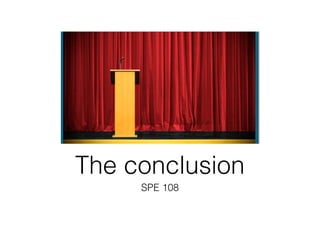
Conclusion
- 1. The conclusion SPE 108
- 2. The conclusion • Your closing remarks are your last chance to drive home your ideas! • The conclusion has two major functions: 1.To let the audience know you are ending the speech 2.To reinforce the audience's understanding of, or commitment to, the central idea
- 3. Signal to end the speech •Sometimes a speaker ends so abruptly it takes you by surprise; a sudden ending will leave the audience puzzled and unfulfilled •Vocal cues: "in conclusion," "my purpose has been,""let me end by saying."
- 4. Signal to end the speech • Manner of deliver y: by use of the voice - it's tone, pacing, intonation, and rhythm - a speaker can build the momentum of a speech so there is no doubt when it's over • Dissolve ending: a conclusion that generates emotional appeal by fading pet by step to a dramatic final statement
- 5. Reinforce the central idea • Summarize your speech: restate the main points • End with a quotation: when you find a brief quotation that perfectly captures your central idea, keep it in mind for a possible conclusion
- 6. Reinforce the central idea • Make a dramatic statement: utilize pausing and inflection for maximum impact • Refer to the introduction: gives your speech psychological unity by referring to ideas from the introduction in the conclusion
- 7. Tips for preparing the conclusion • As with the introduction, keep an eye out for possible concluding materials as you research and develop the speech. • Conclude with a bang, not a whimper. Be creative, use emotional appeal and drama. Work a few different endings, and choose the one with the most impact. • Don't be long winded. Your conclusion should be about 10% of your total speech. • Don't leave anything in your conclusion to chance. Work it out in detail, and practice delivering it.
